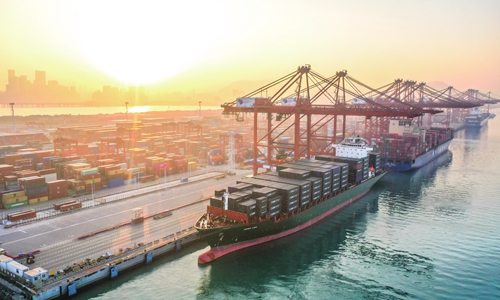
A freighter full of containers prepares to leave the port at the Dachanwan port container terminal in Shenzhen, South China's Guangdong Province, on January 21, 2022. Photo: cnsphoto
China's 8.1 percent GDP increase in 2021, following on from 2.2 percent in 2020, exceeded that of any other major economy. However, as is well known, China's year-on-year growth rate fell to 4.9 percent in the third quarter in 2021 and 4.0 percent in the fourth quarter, showing downward economic pressure.
Furthermore, China's economy was aided in 2021 by an exceptionally strong trade performance. China's annual imports rose in dollar terms by 30.1 percent in 2021 and exports rose by 29.9 percent. There were therefore signs of a slowing of very rapid growth of trade at the end of 2021 - although this was less sharp than for GDP.
Taking a three-monthly average, to avoid distortions caused by single month's figures, annual growth of China's exports fell from 30.7 percent in June to 23.3 percent in December, while the annual growth rate of imports fell from 37.1 to 19.5 percent. Whether such a strong trade performance as in 2021 can be repeated in 2022, clearly depends not only on conditions in China but on the state of the global economy.
Therefore, in addition to the assessment of China's growth in 2021, it is necessary to look at both domestic and international facts to see economic perspectives.
Starting with the international economy, there are strong reasons to conclude that global growth in 2022 will be weaker than in 2021. This is due both to general economic conditions and the strongly inflationary side effects of the type of stimulus packages which were launched by the Trump and Biden administrations. Unless inflationary pressures are to become out of control, the US will force a significant tightening of the US monetary policy with consequent downward pressure on growth in the world's largest economy.
Similar pressures are likely in the European Union - the other major centre of the world economy in addition to the US and China. The effects of this US inflationary pressure are therefore a significant risk for the world economy.
Looking at this danger in detail, in December, the US consumer price inflation reached 7.0 percent - the highest rate for 40 years. Asset price inflation was even sharper - by October 2021, the latest data, the US house prices had increased by 19.1 percent year-on-year, which was even more rapid than the 14.1 percent before the sub-prime mortgage crisis. But such inflation was predictable given the nature of the stimulus packages launched by the Trump and Biden administration.
Taking fiscal policy, the US government spending increased by 9.7 percent of GDP in 2019-2020, which was the largest increase in the US history apart from the World War II. The US monetary policy was equally expansionary, with the annual increase in M3 money supply reaching a peak of 27 percent - an increase almost twice as high as any other period in the last 60 years.
This enormous fiscal and monetary stimulus in the US was almost entirely focused on the consumer sector of the economy. Between the last quarter of 2019, the last before the pandemic, and the third quarter of 2021, the latest available data, the US consumption increased by $1,571 billion. In comparison, the US net fixed investment that is taking into account of the depreciation, rose by $22 billion - or by only 1.4 percent of the increase in consumption. In short, an enormous increase in demand was pumped into the US economy while almost nothing was contributed to the supply side. Under conditions where there was no great unused capacity in the US economy, and a huge surge on the demand side of the economy, with no significant increase on the supply side, meant an inflationary surge was inevitable - and has duly taken place.
What led to US' serious error in economic policy? From a theoretical viewpoint it was the false conception that consumption is a contribution to economic growth. But this is simply false. Consumption, by definition, is not an input into production. So, the huge increase in consumption launched by the Trump or Biden stimulus packages did not aid the supply side of the US economy.
From the political viewpoint the reason the Trump or Biden stimulus packages were entirely focused on consumption was because the US is a capitalist economy - that is, by definition, one in which the private sector has a dominant role in the means of production. This capitalist class, consequently, does not mind the state stimulating consumption, but it does not want it intervening in investment, that is in control of the means of production.
For this reason, the only time the US has pursued an investment, a supply side, led stimulus policy was during the World War II - when the total priority of the US was to defeat Japanese militarism and Nazi Germany. By 1944, 79 percent of fixed investment in the US was in the state sector. This achieved the greatest economic growth in the US economic history.
Between 1940 and 1944, the US grew by 15 percent a year, the fastest short-term growth recorded by a major economy in world history. But this huge state intervention into the US economy was against the interests of private capital - the share of wages, compared to profits, in the US economy rose for three decades and inequality of income and wealth was sharply reduced. Consequently, except when facing mortal peril such as war, the US capital was determined that there would never again be a large-scale state-led investment programme even if this resulted in slow economic growth in the US.
Therefore, because of the confused economic theory and political relations, Trump or Biden launched an almost entirely consumer focused US stimulus programme which inevitably produced the inflationary consequences already outlined. The inflationary consequences of this now require tightening of the US monetary policy which will slow its economy.
Given the US economy's size that resulting in the US monetary policy tightening, generally expected to be launched by the Federal Reserve in March at the latest, will inevitably have consequences not confined to the US. An increase in Federal Reserve interest rates will put upward pressure on interest rates in numerous countries. It is also likely to put upward pressure on the dollar's exchange rate. This combination will have negative economic consequences for a number of countries.
It is to be hoped that the world will join hands to manage these financial risks, including via the IMF and G20, but nevertheless these risks will continue to exist, and sufficient multilateral action cannot be guaranteed.
This situation clearly has economic consequences for China. The economic growth for 2021 met projections. But there was significant downward pressure at the year's end. Meanwhile, China's trade was somewhat slowing and there are negative trends in the world economy. Therefore, it is difficult to escape the conclusion that there must be a domestic stimulus during 2022, if the negative trends in the world economy are to be avoided.
But it is also important to understand the unfavourable lessons of the Trump or Biden stimulus packages and therefore to note that a stimulus in China only on the demand side of the economy, that is on consumption, will have negative consequences. Instead, stimulus will have to significantly include the economy's supply side - that is investment.
In summary, China in 2022 will face more negative global economic trends than in 2021. This will clearly require more domestic stimulus in China while making it necessary to avoid the errors of Trump or Biden administrations.
John Ross is Senior Fellow at Chongyang Institute for Financial Studies, Renmin University of China. He was formerly Director of Economic and Business Policy for the Mayor of London.

John Ross Photo: Courtesy of John Ross





